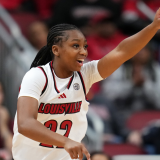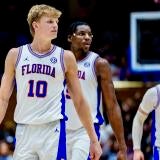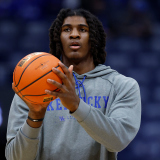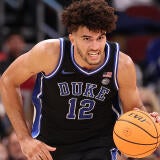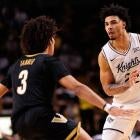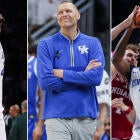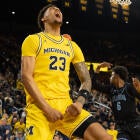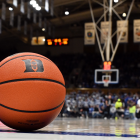2025 NCAA Tournament champion contenders by tiers: 20 teams with realistic chance at winning national title
Which teams are no-brainers, on the doorstep or dark horses to be cutting down the nets in April
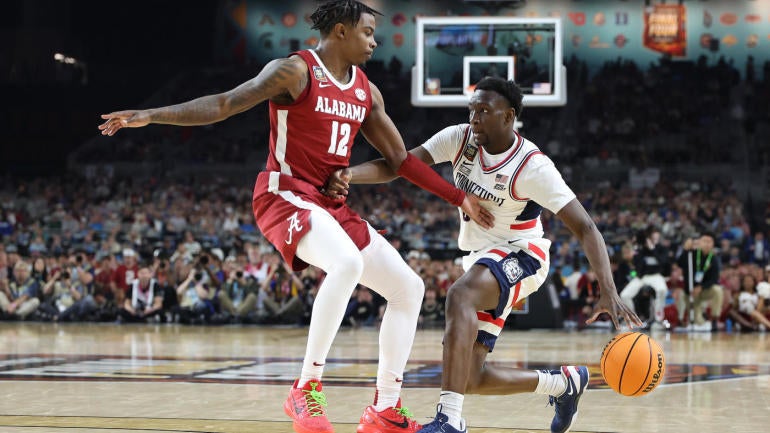
The road to San Antonio starts Monday when IU Indy – formerly known as IUPUI – tangles with IU Columbus at 11 a.m. ET to get the 2024-25 college basketball season underway. Feel the excitement.
Thus starts the long, fierce debates of who truly is a national championship contender or not.
Sadly, there is no magic formula.
Will Warren, engineer of Stats By Will, has long debunked the fallacy-laden "20/20 club" that incorrectly states that to win the national championship, a team must rate in the top 20 nationally in both offensive and defensive efficiency. Actually, 10 of the past 21 national champions have rated outside of the top 20 in offensive or defensive efficiency heading into the Big Dance.
So, what are the parameters? Has every national champion since 2002 rated inside KenPom.com's top 25 entering the NCAA Tournament? Sure. Has each of the past 22 champions rated inside the top 57 offensively and the top 44 defensively entering March Madness? Yup.
It sure helps to be good on both ends of the floor if you want to reel off six (or seven) straight do-or-die wins to take the championship belt, but college basketball is changing. Of course, defense still matters. No one is saying otherwise, but if you want to win it all, champions have to score at an elite rate. Offenses are erupting. Last year was the highest-scoring season in the history of the sport. The rules have changed. Teams are making more free throws, turning it over less and taking more 3-pointers. Processes have gotten better with more programs embracing winning the math with either shot volume or shot quality.
It doesn't feel like a coincidence that three of the best four offenses entering the Big Dance met in the Final Four. The teams who can't score with variety and efficiency feel doomed from the start.
Let's dive into the preseason national championship tiers, split three ways.
Tier 1: No-brainers


Houston
The scoop: Houston dominates the shot-volume game. Houston averaged 10 more shot attempts than its opponents because it refuses to turn it over, crushes teams on the offensive glass and rips the ball away left and right. Kelvin Sampson has a winning formula and a roster loaded with returners to execute it again. Life without Jamal Shead will not be easy, but what if Houston is, uh, better? Depth was Houston's bugaboo last year. It's a strength this season. Houston is going to bludgeon teams into submission all year.

Iowa State
The scoop: Iowa State's spur-of-the-moment trapping is so hard to simulate, and it's helped T.J. Otzelberger's club rack up a 24% turnover rate in three-straight seasons. With Tamin Lipsey and Keshon Gilbert returning, Iowa State's ball-hawking ways won't be disappearing anytime soon. Saint Mary's transfer Joshua Jefferson and Northern Iowa transfer Nate Heise are hand-in-glove fits for this defense, and they both help elevate the offensive ceiling for this unit.
That sophomore surge for feathery sniper Milan Momcilovic is going to be a thing, and sharpshooter Curtis Jones is one of the best sixth men in the country. Throughout his eight-year head coaching career, Otzelberger has never finished inside the top 30 offensively. Hot take: that's going to change this season.

Kansas
The scoop: The pieces just seem to make more sense for a loaded Kansas roster. KU's transition scoring was way down last year. Alabama transfer Rylan Griffen was a transition sniper. Kansas needed more wing pop. Wisconsin transfer AJ Storr was one of the top scoring wings in the portal. Kansas had no one who was comfortable getting buckets against drop coverage last year, but South Dakota State transfer Zeke Mayo is a midrange maestro who can also shoot it from downtown.
Those three newcomers should make everything so much easier for Dajuan Harris Jr., KJ Adams Jr. and Hunter Dickinson. Harris, especially, has slipped off a tad lately, but he's poised for a big bounceback campaign, especially if KU's improved depth can give him more time to rest.

Arizona
The scoop: There's a proof of concept for Tommy Lloyd that will work in the Big 12, just like it did in the Pac-12. Arizona is an elite rebounding team that turns on the turbo jets in transition. It has had one of the top transition offenses in the sport since Lloyd sauntered into Tucson in 2021.
Jaden Bradley, KJ Lewis and Motiejus Krivas are three excellent defenders, and Caleb Love's playmaking was vastly improved in Year 1 under Lloyd's tutelage. Arizona has a few shooting concerns, but Campbell transfer Anthony Dell'Orso can help out with that, and Oakland transfer Trey Townsend provides another halfcourt offensive hub who can solve problems. Arizona is going to be awesome on both ends.

Duke
The scoop: Duke's upside is ludicrous thanks to elite positional size. Duke's starting backcourt of Tyrese Proctor, Caleb Foster and Kon Knueppel checks in at 6-foot-6, 6-5 and 6-7, respectively. Oh, and Cooper Flagg's frontcourt sidekick, Khaman Maluach, is all of 7-2 and 250 pounds. Duke's defense should be excellent, and it'll turn stops into buckets all year long in transition. Flagg is the headliner, but this roster is just jam-packed with dudes and depth. Jon Scheyer has everything he needs to win a title.

Alabama
The scoop: Nate Oats and one of the best coaching staffs in the country is armed with maybe the deepest roster in the sport. Mark Sears is simultaneously one of the top long-range assassins and a free throw merchant. Cliff Omoruyi shores up a rim defense that needed serious help and the shooting up and down this roster is chef's kiss. Keep an eye on Labaron Philon and Derrion Reid. The pair of high-feel freshmen already look like legitimate dudes who will be needle-movers on both ends. Also, when Chris Youngblood gets healthy, watch out.


Auburn
The scoop: Rim dominance matters. With Donovan Clingan off to the NBA, the table is set for Auburn to have the best rim defense in the sport. Auburn's duo of Johni Broome and Dylan Cardwell are elite rim protectors, and Bruce Pearl is experimenting with playing both guys together for stretches. Broome's offensive brilliance makes it possible. The 6-10, 240-pound big man is a pro who chose to cash in at the college ranks for another year. Thanks, NIL.
He can pass, dribble and shoot in ways that few centers can replicate. Oh, and this backcourt is way, way better after some of its more erratic members hit the portal. Georgia Tech transfer Miles Kelly is an excellent shooter who will take higher-quality looks at Auburn than he did at Georgia Tech. That Year 2 transfer jump for Chad Baker-Mazara and Denver Jones will be real, and Furman transfer JP Pegues is one of the top off-the-bounce shooters in the country. But Auburn will give Alabama a serious run for the SEC crown because Broome, for my money, is the best player in the country.

Baylor
The scoop: Baylor has five guards who would start for 99% of teams in America. Duke transfer Jeremy Roach is a legitimate Big 12 Player of the Year candidate in a Baylor system that routinely gets the best out of its personnel.
Five-star freshman guard VJ Edgecombe wants to posterize literally anyone who gets in his path, and the paint will be wide open for his turbo drives thanks to the addition of do-it-all, 5-man Norchad Omier. Interior defense is a question, but Baylor's been one of the best offenses in the country without a five-out center. Now, it has one. Bombs away.

Gonzaga
The scoop: It's hard to find a more consistent pick-and-roll offense in college basketball than Gonzaga. Mark Few has this thing humming. In 14 of the last 16 years, Gonzaga rates in the 90th percentile or higher in pick-and-roll efficiency, per Synergy. The names and faces on the roster change.
The clinic remains. All-American candidates like Ryan Nembhard and Graham Ike should be even better thanks to the patented Year 2 transfer jump, and they will fuel Gonzaga all year. Nolan Hickman, Khalif Battle and Michael Ajayi headline a supporting cast filled with ballers. This is one of the oldest teams in the sport and will be in the thick of it to build the No. 1 offense in the country.

UConn
The scoop: When you win two national championships in a row and retain this caliber of coaching staff, you get to be in Tier 1. Them's the rules. UConn believes it has an All-American in Alex Karaban, but it's way more than a one-man band. Sophomore Solo Ball's time is now, and Saint Mary's transfer Aidan Mahaney is a lights-out, catch-and-shoot sniper who is joining the system that created the most unguarded catch-and-shoot 3-pointers.
Five-star freshman Liam McNeeley adds another high-feel freshman shotmaker, and the defensive identity should be intact with Hassan Diarra pestering opposing lead guards and Samson Johnson flying around at the back end. Can Tarris Reed follow the Adama Sanogo development arc?
Tier 2: On the doorstep

Tennessee
The scoop: Tennessee's defense is a staple, and it'll be as vicious as ever with Jahmai Mashack, Zakai Zeigler and Felix Okpara – three of the best defenders at their respective positions – roaming the floor. But Tennessee's offense might not take much of a step back, even without the fearless Dalton Knecht. It has numerous buttons it can press to find cracks.
The Zeigler-Okpara, pick-and-roll game will be a tough guard. The Vols loaded up on spot-up shooters, headlined by Chaz Lanier. Plus, Charlotte transfer Igor Milicic Jr. has some intriguing playmaking that Tennessee can utilize at the top of the key.


North Carolina
The scoop: UNC has the speed to be the best transition offense in the country. Elliot Cadeau, RJ Davis, Seth Trimble and Ian Jackson give Hubert Davis four guards who have rockets attached to their sneakers. UNC's big man platoon of Ven-Allen Lubin and Jalen Washington should be so productive thanks to these guards, and Belmont transfer Cade Tyson provides that catch-and-shoot assassin every good team needs. Drake Powell might require patience offensively, but the five-star freshman is a whale of a defender already.
Also, let's jump back to Davis. That guy is just casually back for Year 5. I think he's college basketball's best overall shooter. If you disagree, go argue with a wall. UNC can elevate into Tier 1 if the rim defense and rebounding aren't a severe problem.

Creighton
The scoop: Creighton's passive defense, anchored by legendary center Ryan Kalkbrenner, turns many games into a jump-shooting contest. Creighton is built to win those H-O-R-S-E-like games. Steven Ashworth is a dynamic sniper, and Creighton has a plan to maximize now-healthy Texas Tech transfer Pop Isaacs. Arizona State transfer Jamiya Neal gives Greg McDermott a long-armed, rangy defender to execute the drop-coverage scheme, and freshman sharpshooter Jackson McAndrew is one of the best recruits Creighton has ever landed. Can Creighton get Fedor Zugic eligible? If so, whew.

Texas Tech
The scoop: Texas Tech can play so many different ways offensively and defensively. Elijah Hawkins is a dynamic, set-the-table point guard who can throw pinpoint lobs to leapers or snipers. Texas Tech has both of them in spades. Chance McMillian, Darrion Williams and Kerwin Walton are catch-and-shoot, net-shredders. JT Toppin, Federiko Federiko and Devan Cambridge can go up and get 'em.
Texas Tech freshman Christian Anderson Jr. has also impressed in preseason workouts, and Drake transfer Kevin Overton is a nasty point-of-attack defender who can help insulate some of Hawkins' limitations on that end. Texas Tech can play big or play small and that's invaluable when you sometimes need six different gameplans to win six different games in March. The Big 12 is loaded but Texas Tech is stacked.

Purdue
The scoop: Purdue is the only high-major team that has two starting guards (Fletcher Loyer and Braden Smith) who are entering Year 3 together. That continuity should loom large. Smith is the Big Ten's best player, and he's a stone-cold killer in late-clock situations. His teammates rave about him. His opponents do, too.
With Zach Edey gone, Trey Kaufman-Renn is about to get fed a bevy of post-ups. Purdue's ceiling is lower without its two-time national player of the year (duh!), but the Boilermakers are bullish on its player-development program flexing its muscles with guys like Will Berg, Myles Colvin and Camden Heide. Matt Painter also believes he has another freshman, Gicarri Harris, who is ready for prime time. Fellow freshman Daniel Jacobsen, a 7-3 skyscraper, will be ready to roll sooner rather than later, as well.
Tier 3: Dark horses
Just the top five of these. We'd be here all day if they'd let me do more .

Kentucky
The scoop: Mark Pope's process offensively is going to be outstanding. This roster is filled with veterans who can pass, dribble and shoot a million 3-pointers. Plus, this point-of-attack defense should be stiff whenever Otega Oweh or Lamont Butler is on the floor. If Kentucky's 3-pointers are falling in March, it can rattle off numerous wins in a row.

Illinois
The scoop: Illinois will be a bit of a slow burn. Other teams are way ahead of the young Illini now, but Brad Underwood's group could pass them up in Winning Time. Illinois' roster is stocked with skilled size and shooting.
Freshman guard Kasparas Jakucionis is already generating lottery hype, but Tomislav Ivisic and Ben Humrichous form arguably the best-shooting frontcourt duo in the country. That should open the paint for this offense to hit overdrive. Can Illinois avoid turnovers and stop a soul defensively? It might not look pretty in November, but it could look disgusting (in a good way) in March.


Wake Forest
The scoop: When you have a dude, you have a chance. Wake Forest has one of 'em in Hunter Sallis who can go toe-to-toe with anybody. Everyone wants three-level scorers, but Sallis actually is one. The All-American candidate has a much more athletic supporting cast, headlined by Cam Hildreth, Efton Reid, Omaha Biliew, Tre'von Spillers and Parker Friedrichsen. Steve Forbes might have up to 10 guys he can trust to play real minutes. That depth is a luxury.

St. John's
The scoop: Rick Pitino has a roster more equipped to play Rick Pitino basketball. Deivon Smith and Kadary Richmond provide a two-headed monster at point guard. Smith is awesome in transition. Richmond is awesome in the halfcourt. That gives St. John's some much-needed variety offensively, and these role players are rock-solid.
RJ Luis is a beast on the wing. Zuby Ejiofor is a monster in the paint. Aaron Scott was one of the top 3-and-D forwards in the portal. If freshman Jaiden Glover can pop, St. John's will have all the ammunition it needs to make major noise, and Pitino is as good with the X's and O's as anybody this side of Dan Hurley.

UCLA
The scoop: Mick Cronin doesn't take losing well, so he built a roster with numerous outs. Each guy in that club better prepared to fight for his spot in Every. Single. Practice. UCLA has 14 guys who believe they can be high-major rotation players. There's only so much room at the inn. Whoever is on the floor for UCLA will have absolutely earned it.
Some of UCLA's shot diet leaves a bit to be desired (the Bruins take so many tough 2s), but Cronin is a little like Sampson where his teams do everything else so well that it almost doesn't matter. UCLA will offensive rebound, dominate the turnover battle and be total cockroaches for 40 minutes. Don't be surprised if this group doesn't have many dudes dominating statistical leaderboards. It'll be a group effort every night.


